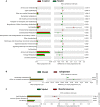Alterations of the Gut Microbiome Associated With the Treatment of Hyperuricaemia in Male Rats
- PMID: 30283432
- PMCID: PMC6156441
- DOI: 10.3389/fmicb.2018.02233
Alterations of the Gut Microbiome Associated With the Treatment of Hyperuricaemia in Male Rats
Abstract
Hyperuricaemia is an important risk factor for many diseases including gout, hypertension, and type II diabetes. The gut microbiota is associated with hyperuricaemia and has also been demonstrated to play significant roles in the effects of drug therapy. This study used Illumina MiSeq sequencing to explore alterations of the gut microbiome associated with allopurinol and benzbromarone treatment in the male rat with hyperuricaemia. After drug treatment, both allopurinol and benzbromarone caused an increase of the genera Bifidobacterium and Collinsella and a decrease of the genera Adlercreutzia and Anaerostipes. In addition, allopurinol and benzbromarone caused respective unique changes in genera. The genera Bilophila, Morganella, and Desulfovibrio specifically decreased due to allopurinol treatment. Decreased Butyricimonas and Ruminococcus and increased Proteus were caused by benzbromarone treatment. The PICRUST analysis indicated that allopurinol renovated the disorder of nucleotide metabolism and benzbromarone renovated the disorder of lipid metabolism in the gut microbiota of male rats with hyperuricaemia. These findings demonstrated that the gut microbiota may be altered by the treatment of hyperuricaemia with allopurinol and benzbromarone in male rats. Such alterations of the gut microbiota could be considered as indicators of the effectiveness of drug therapy.
Keywords: Illumina MiSeq; allopurinol; benzbromarone; gut microbiome; hyperuricaemia.
Figures






Similar articles
-
[Long lasting normalization of uric acid after combination therapy with 300 mg allopurinol and 60 mg benzbromarone in patients with gout and hyperuricemia].Med Klin (Munich). 1992 Sep 15;87(9):460-2. Med Klin (Munich). 1992. PMID: 1406482 German.
-
A benefit-risk assessment of benzbromarone in the treatment of gout. Was its withdrawal from the market in the best interest of patients?Drug Saf. 2008;31(8):643-65. doi: 10.2165/00002018-200831080-00002. Drug Saf. 2008. PMID: 18636784 Review.
-
Benzbromarone therapy in hyperuricaemia; comparison with allopurinol and probenecid.J Int Med Res. 1981;9(6):511-5. doi: 10.1177/030006058100900615. J Int Med Res. 1981. PMID: 7033016 Clinical Trial.
-
Cardiovascular risk associated with allopurinol vs. benzbromarone in patients with gout.Eur Heart J. 2021 Nov 21;42(44):4578-4588. doi: 10.1093/eurheartj/ehab619. Eur Heart J. 2021. PMID: 34508567 Free PMC article.
-
Benzbromarone: a review of its pharmacological properties and therapeutic use in gout and hyperuricaemia.Drugs. 1977 Nov;14(5):349-66. doi: 10.2165/00003495-197714050-00002. Drugs. 1977. PMID: 338280 Review.
Cited by
-
Hypoglycemic Effect of Prolamin from Cooked Foxtail Millet (Setaria italic) on Streptozotocin-Induced Diabetic Mice.Nutrients. 2020 Nov 11;12(11):3452. doi: 10.3390/nu12113452. Nutrients. 2020. PMID: 33187155 Free PMC article.
-
Taurine alleviates dysfunction of cholesterol metabolism under hyperuricemia by inhibiting A2AR-SREBP-2/CREB/HMGCR axis.J Lipid Res. 2025 Feb;66(2):100746. doi: 10.1016/j.jlr.2025.100746. Epub 2025 Jan 21. J Lipid Res. 2025. PMID: 39848583 Free PMC article.
-
Study on the effects of intestinal flora on gouty arthritis.Front Cell Infect Microbiol. 2024 Aug 8;14:1341953. doi: 10.3389/fcimb.2024.1341953. eCollection 2024. Front Cell Infect Microbiol. 2024. PMID: 39176260 Free PMC article. Review.
-
Hyperuricemia and the gut microbiota: current research hotspots and future trends.Front Microbiol. 2025 Aug 14;16:1620561. doi: 10.3389/fmicb.2025.1620561. eCollection 2025. Front Microbiol. 2025. PMID: 40895468 Free PMC article.
-
Elucidating the role of gut microbiota dysbiosis in hyperuricemia and gout: Insights and therapeutic strategies.World J Gastroenterol. 2024 Oct 28;30(40):4404-4410. doi: 10.3748/wjg.v30.i40.4404. World J Gastroenterol. 2024. PMID: 39494101 Free PMC article. Review.
References
LinkOut - more resources
Full Text Sources

